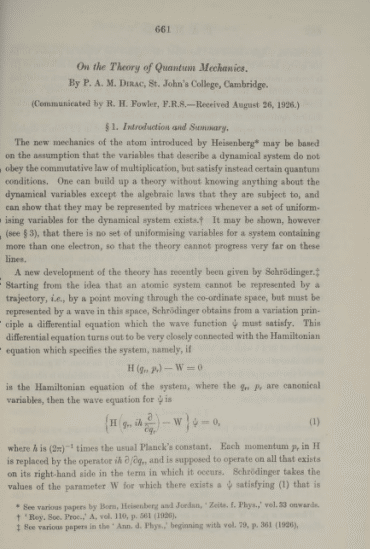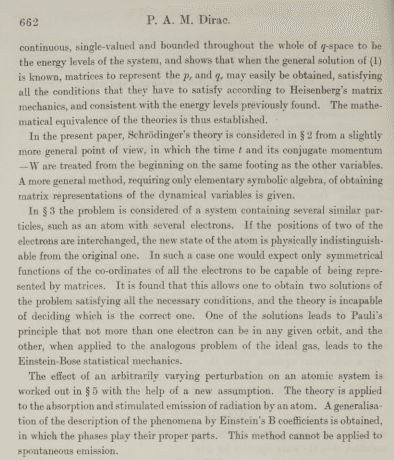
論文をChatGPTを使って清書&解読していく裏ワザ
⇧これの続きです。彼のこの論文の冒頭部分を、OCR読み取りして、コピペでChatGPTに放り込んで「清書してちょ」と指示してみました。


以下、清書されたものです。
On the Theory of Quantum Mechanics
By P. A. M. Dirac, St. John’s College, Cambridge
(Communicated by R. H. Fowler, F.R.S.—Received August 26, 1926.)
§ 1. Introduction and Summary
The new mechanics of the atom introduced by Heisenberg may be based on the assumption that the variables describing a dynamical system do not obey the commutative law of multiplication but satisfy certain quantum conditions. A theory can be developed without knowing anything about the dynamical variables except the algebraic laws they are subject to, and it can be shown that these variables may be represented by matrices whenever a set of uniformizing variables for the dynamical system exists. However, it can be shown (see § 3) that there is no set of uniformizing variables for a system containing more than one electron, so the theory cannot progress very far along these lines.
A new development of the theory has recently been given by Schrödinger. Starting from the idea that an atomic system cannot be represented by a trajectory (i.e., a point moving through coordinate space) but must be represented by a wave in this space, Schrödinger obtains from a variational principle a differential equation that the wave function must satisfy. This differential equation turns out to be closely connected with the Hamiltonian equation which specifies the system. Namely, if
H=H(qn,pr)H = H(q_n, p_r)H=H(qn,pr)
is the Hamiltonian equation of the system, where qnq_nqn and prp_rpr are canonical variables, then the wave equation for ψ\psiψ is
iℏ∂ψ∂t=Hψi \hbar \frac{\partial \psi}{\partial t} = H \psiiℏ∂t∂ψ=Hψ
where ℏ\hbarℏ is (2π)−1(2 \pi)^{-1}(2π)−1 times the usual Planck’s constant. Each momentum prp_rpr in HHH is replaced by the operator −iℏ∂∂qr-i \hbar \frac{\partial}{\partial q_r}−iℏ∂qr∂, which operates on all that exists on its right-hand side in the term in which it occurs. Schrödinger takes the values of the parameter WWW for which there exists a ψ\psiψ satisfying (1) that is continuous, single-valued, and bounded throughout the whole of ψ\psiψ-space to be the energy levels of the system. He shows that when the general solution of (1) is known, matrices to represent prp_rpr and qrq_rqr can easily be obtained, satisfying all the conditions according to Heisenberg’s matrix mechanics, and consistent with the energy levels previously found. The mathematical equivalence of the theories is thus established.
In the present paper, Schrödinger’s theory is considered in § 2 from a slightly more general point of view, in which the time ttt and its conjugate momentum −W-W−W are treated from the beginning on the same footing as the other variables. A more general method, requiring only elementary symbolic algebra, of obtaining matrix representations of the dynamical variables is provided.
In § 3, the problem of a system containing several similar particles, such as an atom with several electrons, is considered. If the positions of two of the electrons are interchanged, the new state of the atom is physically indistinguishable from the original one. In such a case, only symmetrical functions of the coordinates of all the electrons are expected to be representable by matrices. It is found that this allows one to obtain two solutions of the problem satisfying all the necessary conditions, and the theory is incapable of deciding which is the correct one. One of the solutions leads to Pauli’s principle that no more than one electron can be in any given orbit, while the other, when applied to the analogous problem of the ideal gas, leads to Einstein-Bose statistical mechanics.
The effect of an arbitrarily varying perturbation on an atomic system is worked out in § 5 with the help of a new assumption. The theory is applied to the absorption and stimulated emission of radiation by an atom. A generalization of the description of the phenomena by Einstein’s B coefficients is obtained, in which the phases play their proper parts. This method cannot be applied to spontaneous emission.
References:
See various papers by Born, Heisenberg, and Jordan, Zeits. f. Phys., vol. 33 onwards.
Roy. Soc. Proc., A, vol. 110, p. 561 (1926).
See various papers in the Ann. d. Phys., beginning with vol. 79, p. 361 (1926).
うーん数式部分はNOTE上では望むようなフォントではでないのですね。OCR漏れの数式はコピペできないから清書しろと無茶もいえないし。
以下は ChatGPT による翻訳。
量子力学の理論について
著者: P. A. M. Dirac、セントジョンズ・カレッジ、ケンブリッジ
(R. H. Fowler, F.R.S. により伝達—受領日 1926年8月26日)
§ 1. はじめにと要約
ハイゼンベルクによって導入された新しい原子の力学は、動的系を記述する変数が可換法則に従わないが、代わりに特定の量子条件を満たすという仮定に基づいている。この理論は、動的変数に関する情報がその変数が従う代数的法則だけである場合にも構築することができ、動的系に対する均一化変数のセットが存在する場合には、これらの変数を行列で表現できることが示されている。しかし、複数の電子を含む系については、均一化変数のセットが存在しないため、この理論はこれ以上進展することができない(§ 3参照)。
最近、シュレーディンガーによって理論の新たな発展が示された。原子系が軌跡、すなわち座標空間を通る点で表されるべきではなく、この空間内の波として表現されるべきであるという考えから出発し、シュレーディンガーは波動関数が満たすべき微分方程式を変分原理から導出した。この微分方程式は、系を指定するハミルトニアン方程式と非常に密接に関連している。すなわち、
H=H(qn,pr)H = H(q_n, p_r)H=H(qn,pr)
が系のハミルトニアン方程式であり、ここで qnq_nqn および prp_rpr は正準変数であるとすると、波動方程式は
iℏ∂ψ∂t=Hψi \hbar \frac{\partial \psi}{\partial t} = H \psiiℏ∂t∂ψ=Hψ
となる。ここで ℏ\hbarℏ は通常のプランク定数の (2π)−1(2 \pi)^{-1}(2π)−1 倍である。ハミルトニアン HHH の各運動量 prp_rpr は、演算子 −iℏ∂∂qr-i \hbar \frac{\partial}{\partial q_r}−iℏ∂qr∂ で置き換えられ、これはその出現する項の右側に存在するすべてに作用するものとされる。シュレーディンガーは、連続で単値かつ全体的に有界な ψ\psiψ が存在する WWW の値を系のエネルギー準位とし、(1) の一般解が知られるとき、prp_rpr および qrq_rqr を表す行列が簡単に得られることを示している。これにより、ハイゼンベルクの行列力学に従うすべての条件を満たし、以前に得られたエネルギー準位と一致することが確認される。したがって、理論の数学的同等性が確立される。
本論文では、シュレーディンガーの理論を § 2 でやや一般的な観点から考察し、時間 ttt およびその共役運動量 −W-W−W を他の変数と同等に取り扱う方法を導入している。ここでは、動的変数の行列表現を得るための、初等的な記号代数のみを用いる一般的な方法が示されている。
§ 3 では、複数の類似粒子を含む系、例えば複数の電子を持つ原子について考察する。もし2つの電子の位置が入れ替わると、新しい原子状態は元の状態と物理的に区別がつかない。このような場合、すべての電子の座標の対称関数のみが行列で表現可能であると考えられる。この条件を満たす2つの解が得られることがわかり、理論はどちらが正しいかを決定することができない。1つの解は、パウリの原理、すなわち、任意の軌道に複数の電子が存在できないことを導き出し、もう1つは、理想気体の類似問題に適用すると、アインシュタイン-ボース統計力学に至る。
§ 5 では、原子系に対する任意の変動する摂動の影響が、新しい仮定を用いて取り扱われている。理論は、原子による放射の吸収および刺激放射に適用され、エインシュタインの B 定数による現象の記述の一般化が得られ、位相が適切に考慮される。この方法は、自発放射には適用できない。
参考文献:
Born, Heisenberg, and Jordan による様々な論文、Zeits. f. Phys., vol. 33 以降。
Roy. Soc. Proc., A, vol. 110, p. 561 (1926)。
Ann. d. Phys., vol. 79, p. 361 (1926) 以降の様々な論文。
このくらいの精度で十分というところかな論文読解には。続くぶんも、分割して順にやってみると…
つづく
